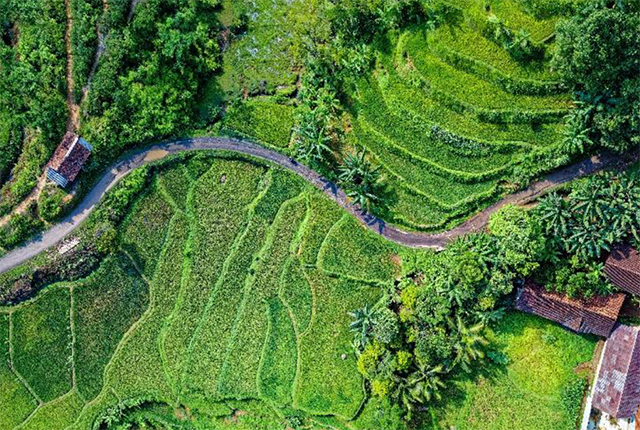New tsunami risk identified in Indonesia
Scientists have identified a potential new tsunami risk in Indonesia by mapping below the seabed of the Makassar Strait.
30/04/2020 By BGS Press
Prof David Tappin, a tsunami expert at the BGS and UCL, was part of a research team led by Heriot-Watt University that used seismic data to map underneath the sea floor of the Makassar Strait, the narrow seaway between the islands of Borneo and Sulawesi.
The team say their findings mean that coastal communities currently without tsunami warning systems or mitigation systems could be at risk.
They found evidence of 19 ancient submarine landslides. Submarine landslides have triggered tsunami waves before, such as the 2018 event on Sulawesi in Indonesia, although most tsunamis are caused by large earthquakes.
Dr Rachel Brackenridge, now at University of Aberdeen, said:
“We found evidence of submarine landslides happening over 2.5million years.
“They happened every 160,000 years or so and ranged greatly in size. The largest of the landslides comprised 600km3 of sediment, while the smallest we identified were five km3. There will be many smaller events that we have yet to identify.”
Dr Brackenridge explained how they identified the ancient landslides.
“Seismic data allows us to image the subsurface. The different characteristics of rocks below the seabed allow us to reconstruct the conditions they were deposited in.
“We can see a layered and orderly seabed, then there are huge bodies of sediment that appear chaotic.
“We can tell from the internal characteristics that these sediments have spilled down a slope in a rapid, turbulent manner. It’s like an underwater avalanche.”
The researchers say that the strong ocean current that flows through the Makassar Strait could be behind the prehistoric events and any potential submarine landslides.
Dr Uisdean Nicholson, who led the research at Heriot-Watt University, said:
“The Makassar Strait is an important oceanic gateway. It’s through there the main branch of the Indonesian Throughflow transports water – over 10 million cubic metres a second – from the Pacific to the Indian Ocean.
“The current acts as a conveyor belt, transporting sediment from the Mahakam Delta and dumping it on the upper continental slope to the south, making the seabed steeper, weaker and more likely to collapse.
“We estimate the largest, tsunamigenic events – those that displace 100 km3 – occurred every 500,000 years.
“Indonesia has mitigation and early warning measures in place in different parts of the country, but not the area that would be affected by a tsunami wave generated from these landslides. This includes the cities of Balikpapan and Samarinda, which have a combined population of over 1.6 million people.
“Such an event could be concentrated and amplified by Balikpapan Bay, the site selected for the new capital city of Indonesia.
“Our next step is to quantify the risk in this area by building various numerical models of landslide events and tsunami generation. This could help us predict a threshold size that causes dangerous tsunamis and help inform any mitigation strategies.
“We also plan to visit the coastal areas of Kalimantan to look for physical evidence for historic or prehistoric tsunamis, to test the model outcomes and further improve our understanding of this hazard.”
Prof Tappin is studying the Sulawesi tsunami which struck the opposite side of the Makassar Strait in September 2018.
Prof Tappin said:
“The new study on submarine landslides is important in demonstrating that the tsunami hazard in this region of Indonesia is possibly greater than previously thought, but more research is necessary to confirm this.”
Dr Nicholson recently identified ancient submarine landslides near the Falkland Islands in a separate research project.
The report was published in a special publication on Submarine mass movements and their consequences by the Geological Society, London.
Relative topics
For further details or to arrange media interviews please contact:
Sarah McDaid – Sarah@mcdaidpr.co.uk / 07866 789 688
OR
Hannah Pole, British Geological Survey Press Office – hapo@bgs.ac.uk / 07565 297 132
Photographs are free for media use with credit to Geological Society: https://drive.google.com/drive/folders/1GXUsYiy7E8mLf4VwKrE93Tjm7Y2nFs1q?usp=sharing
Notes for Editors
The findings
The largest landslide the team identified was around 600km3 – the equivalent of around 1000 Sydney Harbours or approximately 250,000 Great Pyramids of Giza.
The 19 landslides of all sizes happened every 160,000 years or so. The largest landslides – 100km3 and above – happened every 500,000 years or so.
Indonesia Tsunami risk
- South East Asia is particularly prone to tsunamis due to its seismically active geology.
- In the last two years alone, the Palu Bay and Anak Krakatau tsunamis have claimed over 4,000 lives.
- Most tsunamis in the region are triggered by earthquakes, or volcanic activity.
- There are good historical records of past tsunami events and their triggers going back over 200 years.
- However, the past events we identify in this study pre-date historical records, and are triggered by a geological scenario that has not previously been recognised in the area.
- As such, the coastal communities at risk do not benefit from hazard mitigation or early warning systems in place elsewhere in Indonesia.
British Geological Survey
The British Geological Survey (BGS) is a world leading applied geoscience research centre that is part of UK Research and Innovation (UKRI) and affiliated to the Natural Environment Research Council (NERC). BGS core science provides objective and authoritative geoscientific data, information and knowledge to inform UK Government on the opportunities and challenges of the subsurface. It undertakes national and public good research to understand earth and environmental processes in the UK and globally. Please see www.bgs.ac.uk.



